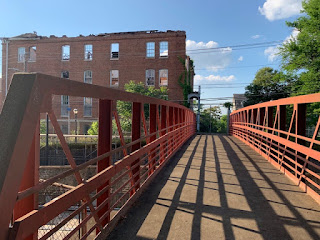Brief History of Morris Brown
Morris Brown was opened in 1885 as a liberal arts
college in Atlanta, Georgia. The school was named after Rev. Morris Brown of
Charleston, South Carolina. He was a second Bishop of the African Methodist
Episcopal (AME) churches, which helped establish the school. Annie B. Thompson
served as the first principal and Laurene Chandler became the first graduate.
Morris Brown was 1 of 5 African American Institutions with the others being
Spelman, Morehouse, Clark, and Atlanta University.
The Fountain Hall was completed years prior in 1882
and was originally used for Atlanta University where it housed administrative
offices and classrooms. Once Atlanta University merged with Clark College to
become Clark Atlanta University, the building was then leased by Morris Brown
in 1929. This currently sits as the oldest building at the college. The
structure is 3-1/2 stories with a masonry structure built out of red brick.
At its peak, the college was home to over 2,500
students offering Baccalaureate Degrees in Management, Entrepreneurship,
Technology, and Organizational Management & Leadership.
Trouble Ahead
In the year 2003, the school lost its accreditation
due to money management problems. The school’s sports program was also
discontinued during this year as well. The institute was also deprived of
federal financial aid and to add fuel on the fire, the institute was also asked
to withdraw from Atlanta University Center Consortium (AUC). It was a consortium that used to back Atlanta
black colleges including Clark Atlanta University, Morehouse College, Morehouse
School of medicine and Spelman College.
Stanley Pritchett Sr., Morris brown’s president said
in 2010 that we lost our accreditation due to some financial issues. He made it
clear that it does not have anything to do with the faculty of the college, the
qualification of the staff members or the curriculum, it happened due to the dreadful
mistakes made in the financial area in the past.
Finally, in 2012, the college filed for chapter 11
bankruptcy according to which a chapter 11 debtor proposes a plan of reorganization
to keep its business alive and pay creditors over time. The college had a debt
of $32 million for 8 or 9 years. In 2015, the college fought out of bankruptcy
and left only with $3 million debt left to be paid. Finally, the school has
made the tough decision of selling a chunk of Morrison brown’s campus to save
the school.
Since 2003, the college provided less than 200
graduated students through fewer fees and scholarships in the hope that one day
their degree will have a full value of accreditation. The school has been
working on getting its accreditation back and hopefully, Morris brown will
receive its accreditation by the end of the year 2019.
Morris Brown has accepted 25 freshmen in the academic
year of 2018-2019 and also looking forward to having 15 returning students back
to its campus. More than 1000 students have already shown interest in the
college for the upcoming academic year.
The worst days of Morris brown are almost over and it
is looking forward to getting its accreditation back in a short time. It has
proven over time that it is here to stay and it will get back on its feet in no
time.
Today
Upon arriving at the
school, most of the buildings are either bordered up or burned down due to
fire. There is one building they continue to use today as an administrative office that has a few classrooms.
The first building that
was entered was the former John H. Lewis Recreation Building. This building
housed swimming, basketball courts, fitness rooms, and a game room. The building
was very messy and had a very foul urine smell. The basketball court was in
great condition compared to other parts throughout the building. As a group, we
encountered homeless people and even spoke to some of them that claimed they’ve
been there for months. Some even had jobs and operating cell phones, but no
place to stay. We entered the indoor swimming pool area as well which was very
dark.
As leaving the building
we encountered the Fountain Hall Building which is decaying very badly and
boarded up.
The last building we
visited was a 5-story building that housed a cafeteria, general classrooms, and
a library. The cafeteria remained intact with minor vandalism. A lot of the
school’s signage was found throughout this building.
The former dorm rooms were
too dangerous to explore due to it being partially collapsed and damaged by
fire. If this school ever wants to house students on campus, new dorm buildings
will need to be constructed. When visiting this school, I encourage that you do not go alone and be prepared to run into homeless people.
Abandoned Morris Brown College Bus
Interior School Photos


Exterior Shots
Herndon Stadium (Future Blog)
Used during the 1996 Olympics and also for the former sports team at Morris Brown College (MBC Wolverines). Along with the school, financial hardships lead to the stadium falling in disrepair.


































.png)
No comments:
Post a Comment